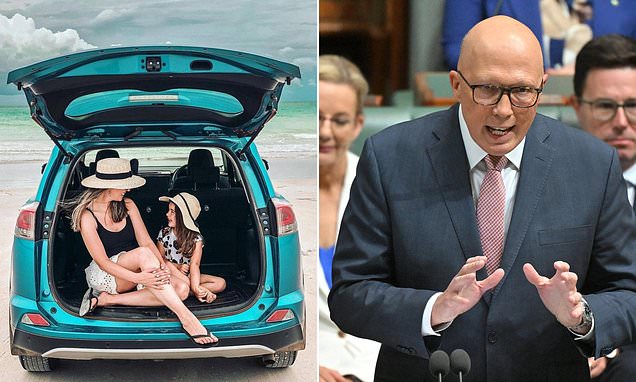Mums who drive a medium-sized SUV could decide the next election if Peter Dutton’s plan to halve the fuel tax wins over the vital undecided voters on May 3.
The Opposition Leader’s Budget-reply speech suggested halving the fuel excise from 50.8 to 25.4 cents a litre, for a year, would save motorists $14 a week.
‘For a household with one car filling-up once a week, that’s a saving of $14 a week on average – or around $700 over 12 months,’ he told Parliament on Thursday.
‘For a household with two cars filling-up once a week, that is a saving of $28 a week on average – or around $1,500 over 12 months.’
Those calculations were based on a car with a 55-litre tank which perfectly describes the Toyota RAV4, ‘s best-selling vehicle in February.
The Mitsubishi Outlander, ‘s fifth most popular also has a 55-litre tank, while the Mazda CX-5, the eighth most popular car, has a 56 litre tank, compared with 54 litres for the Kia Sportage, which was ninth on the monthly Federal Chamber of Automotive Industries sales chart.
Mums are more likely to drive a mid-sized SUV rather than a Toyota HiLux or Ford Ranger ute, with a bigger 80-litre fuel tank.
While Mr Dutton’s Budget reply speech announced new tax breaks to benefit mainly male tradies, a mother struggling to pay the bills was a key focus.
‘In Perth, a mum in a grocery store, in tears, told me how her, her husband and children couldn’t keep their heads above water with the bills stacking up,’ he said.
Simon Kuestenmacher, a co-founder of The Demographics Group, said Mr Dutton was trying to win back female voters who had deserted the Liberal Party.
‘They must know this in the Liberal camp that he polls poorly with women and so they try and soften his image,’ he said.
‘There’s strategy there to soften him for the female vote but maybe it’s a bit too much just to say, “Women go absolutely crazy once you give them a bit of money off the petrol pump”.’
But Pru Goward, a former sex discrimination commissioner and NSW Liberal minister, said the fuel excise cut would be popular with middle n families who owned a medium-sized SUV.
‘I don’t think it’s going to come down to RAV4 drivers but I agree with you: it’s very well targeted to middle and middle often feels forgotten by Labor governments, Mr Dutton’s making sure they won’t be,’ she told Daily Mail .
‘The key to switching marginal seats is obviously the cost-of-living crisis.
‘It would save on petrol and that means that you do have a bit more money to buy fruit and vegetables and the right things for your children to eat.
‘We know fresh food is unnecessarily expensive partly because it needs transport and anything that’s got a high transport cost is particularly affected by fuel prices.’
Ms Goward disputed the suggestion the fuel excise cut was about winning over female voters, given mums typically balance household budgets.
‘He’s not playing a game with the gender card, he is targeting it at families that need relief,’ she said.
The Coalition is targeting Labor’s 15 most marginal seats on buffers under five per cent – with nine of those electorates in outer suburban and regional areas where voters are more reliant on cars than public transport.
This includes the NSW South Coast seat of Gilmore, which is now sitting on a ultra-thin margin of 0.2 per cent.
‘There’s absolutely no doubt marginal and regional areas, the car is king, we cannot live in our regional towns without a car; public transport just isn’t an option,’ Ms Goward, who lives in regional Goulburn, said.
Mr Dutton is using Facebook memes to highlight how the Coalition’s fuel excise cut would come into effect immediately if it won the next election being held on May 3.
‘Immediate financial relief – $14 per tank,’ it said with a green tick.
On the other side was frowning image of Prime Minister Anthony Albanese with the red X tag: ’15 month wait for tax tweak: 70c a day in 15 months time.’
Prime Minister Anthony Albanese’s Tuesday night Budget included an extra $268 a year in tax relief as the tax rate, for those earning $18,200 to $45,000, was reduced to 15 per cent from 16 per cent from July 1, 2026.
That worked out at $5.15 a week or 74 cents a day.
The tax rate is falling to 14 per cent from July 1, 2027, which would provide another $268 in tax relief, as part of a $17billion plan over four years.
The Coalition is going to the election with a rehash of a 2022 policy on fuel excise.
Former prime minister Scott Morrison’s last Budget before that election halved fuel excise for six months, from March to September that year.
This saw excise halved from 44.2 cents a litre to 22.1 cents a litre.
That was when Russia’s Ukraine invasion pushed unleaded petrol prices above $2 a litre, but fuel is now selling for less than $1.80 a litre in parts of western Sydney.
Fuel excise is indexed every year for inflation.
